
The unification of Italy, also known as the Risorgimento, was the 19th-century political and social movement that resulted in 1861 in the consolidation of different states of the Italian Peninsula and its outlying isles into a single state, the Kingdom of Italy. Inspired by the rebellions in the 1820s and 1830s against the outcome of the Congress of Vienna, the unification process was precipitated by the Revolutions of 1848, and reached completion in 1871 after the capture of Rome and its designation as the capital of the Kingdom of Italy.
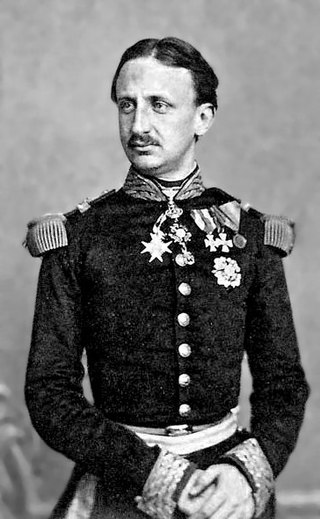
Francis II was King of the Two Sicilies from 1859 to 1861. He was the last King of the Two Sicilies, as successive invasions by Giuseppe Garibaldi and Victor Emmanuel II of Sardinia ultimately brought an end to his rule, as part of Italian unification. After he was deposed, the Kingdom of the Two Sicilies and the Kingdom of Sardinia were merged into the newly formed Kingdom of Italy.

The Volturno is a river in south-central Italy.
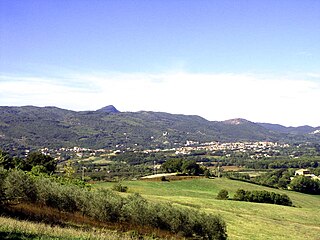
The province of Caserta is a province in the Campania region of southern Italy. Its capital is the city of Caserta, situated about 36 kilometres (22 mi) by road north of Naples. The province has an area of 2,651.35 square kilometres (1,023.69 sq mi), and had a total population of 924,414 in 2016. The Palace of Caserta is located near to the city, a former royal residence which was constructed for the Bourbon kings of Naples. It was the largest palace and one of the largest buildings erected in Europe during the 18th century. In 1997, the palace was designated a UNESCO World Heritage Site.

The Expedition of the Thousand was an event of the unification of Italy that took place in 1860. A corps of volunteers led by Giuseppe Garibaldi sailed from Quarto near Genoa and landed in Marsala, Sicily, in order to conquer the Kingdom of the Two Sicilies, ruled by the Spanish House of Bourbon-Two Sicilies.

The siege of Gaeta was the concluding event of the war between the Kingdom of Sardinia and the Kingdom of the Two Sicilies, part of the unification of Italy. It started on 5 November 1860 and ended on 13 February 1861, and took place in Gaeta, in today's Southern Lazio (Italy).
Dugenta is a comune (municipality) in the Province of Benevento in the Italian region Campania, located about 35 kilometres (22 mi) northeast of Naples and about 30 kilometres (19 mi) west of Benevento.
Liborio Romano was an Italian politician.
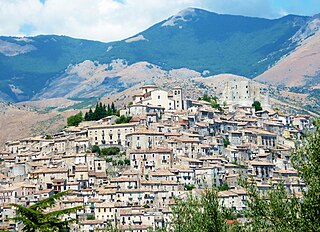
The Battle of Campo Tenese saw two divisions of the Imperial French Army of Naples led by Jean Reynier attack the left wing of the Royal Neapolitan Army under Roger de Damas. Though the defenders were protected by field fortifications, a French frontal attack combined with a turning movement rapidly overran the position and routed the Neapolitans with heavy losses. The action occurred at Campotenese, a little mountain village in the municipality of Morano Calabro in the north of Calabria. The battle was fought during the War of the Third Coalition, part of the Napoleonic Wars.
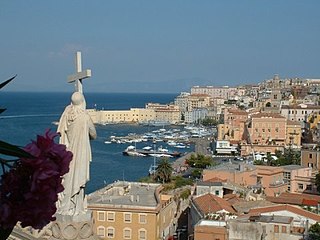
The Siege of Gaeta saw the fortress city of Gaeta and its Neapolitan garrison under General Louis of Hesse-Philippsthal besieged by an Imperial French corps led by Marshal André Masséna. After a prolonged defense in which Hesse was severely wounded, Gaeta surrendered, and Masséna granted its garrison generous terms.

The Battle of Milazzo was fought on 17–24 July 1860 between Giuseppe Garibaldi's volunteers and the troops of the Kingdom of Two Sicilies at Milazzo, Sicily, then part of the Kingdom of Two Sicilies.
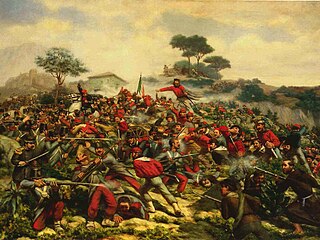
The Battle of Calatafimi was fought on the 15 May 1860 between Giuseppe Garibaldi's Redshirts and the troops of the Kingdom of the Two Sicilies at Calatafimi, Sicily, as part of the Expedition of the Thousand. The battle was the first of Garibaldi's victory during his invasion of Sicily in 1860 and saw his 'Thousand' defeat a larger Neapolitan army sent from Palermo to block the roads to the Sicilian capital.
The Army of Naples was a French Army unit which took this name following its capture of Naples in 1799. It was related to the Army of Italy. The Army of Naples was virtually annihilated after the Battle of the Trebbia: more than half of the personnel were casualties.
Giuseppe Bardari was an Italian lawyer and writer. Although chiefly known today for having written the libretto for Donizetti's 1835 opera, Maria Stuarda, he played a prominent role in the judiciary of Naples in the years leading up to the unification of Italy.

The Invasion of Naples was a front during the War of the Third Coalition, in 1806, when an army of the French Empire led by Marshal André Masséna marched from northern Italy into the Kingdom of Naples, an ally of the Coalition against France ruled by King Ferdinand IV. The Neapolitan army was defeated at Campo Tenese and rapidly disintegrated. The invasion was eventually successful despite some setbacks, including the prolonged Siege of Gaeta, the British victory at Maida, and a stubborn guerrilla war by the peasantry against the French. Total success eluded the French because Ferdinand withdrew to his domain in Sicily, where he was protected by the Royal Navy and a British Army garrison. In 1806, Emperor Napoleon appointed his brother Joseph Bonaparte to rule over southern Italy as king.

The British Legion was a military corps composed of English and Scottish volunteers, who in 1860 joined Giuseppe Garibaldi during the Expedition of the Thousand and fought for the unification of Italy, together with the Italian Redshirts, as part of their Southern Army against the Bourbon Army of the Kingdom of the Two Sicilies.
The Matese Legion was a group of 240 Italian volunteers that joined Giuseppe Garibaldi in the war for Italian unification in 1861. It was formed in Piedimonte D'Alife, now called Piedimonte Matese, in June 1860, and was officially established on 25 August of the same year. Membership in the legion gradually declined, and it broke apart on 3 March 1861.
Giosuè Ritucci Lambertini di Santanastasia was a military commander and minister of war in the Kingdom of the Two Sicilies.
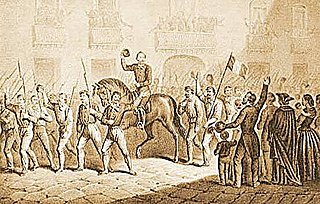
The Southern Army was the force of around 50,000 Italian and foreign volunteers which formed as a result of the Expedition of the Thousand. The name was coined by Giuseppe Garibaldi.

Francesco Landi was a Two Sicilian Brigadier General who was notable for being the main commander at the Battle of Calatafimi against Garibaldi's Redshirts during the Expedition of the Thousand.















